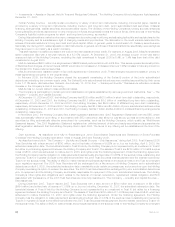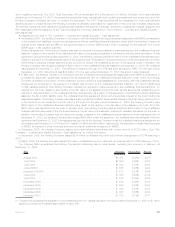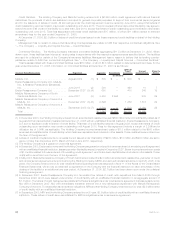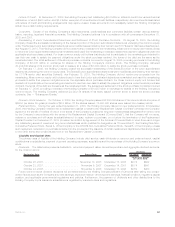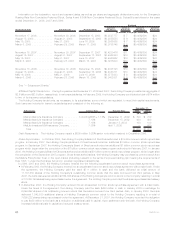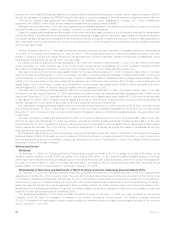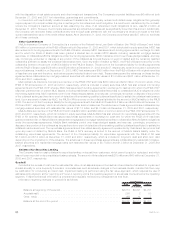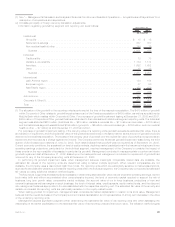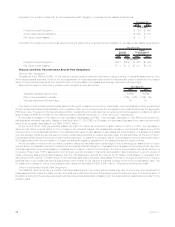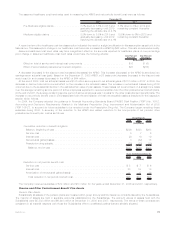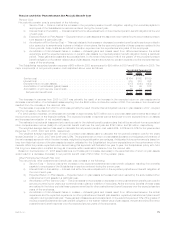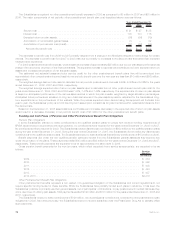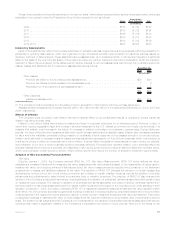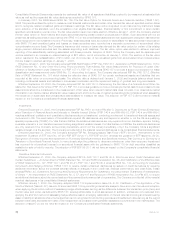MetLife 2008 Annual Report Download - page 73
Download and view the complete annual report
Please find page 73 of the 2008 MetLife annual report below. You can navigate through the pages in the report by either clicking on the pages listed below, or by using the keyword search tool below to find specific information within the annual report.utilized are subject to key judgments and assumptions that are sensitive to change. Estimates of fair value are inherently uncertain and
represent only management’s reasonable expectation regarding future developments. These estimates and the judgments and assump-
tions upon which the estimates are based will, in all likelihood, differ in some respects from actual future results. Declines in the estimated
fair value of the Company’s reporting units could result in goodwill impairments in future periods which could materially adversely affect the
Company’s results of operations or financial position.
Management continues to evaluate current market conditions that may affect the estimated fair value of the Company’s reporting units
to assess whether any goodwill impairment exists. Continued deteriorating or adverse market conditions for certain reporting units may
have a significant impact on the estimated fair value of these reporting units and could result in future impairments of goodwill.
Pensions and Other Postretirement Benefit Plans
Description of Plans
Plan Description Overview
Certain subsidiaries of the Holding Company (“the Subsidiaries”) sponsor and/or administer various qualified and non-qualified defined
benefit pension plans and other postretirement employee benefit plans covering employees and sales representatives who meet specified
eligibility requirements. Pension benefits are provided utilizing either a traditional formula or cash balance formula. The traditional formula
provides benefits based upon years of credited service and either final average or career average earnings. The cash balance formula
utilizes hypothetical or notional accounts, which credit participants with benefits equal to a percentage of eligible pay, as well as earnings
credits, determined annually based upon the average annual rate of interest on 30-year U.S. Treasury securities, for each account balance.
At December 31, 2008, the majority of active participants are accruing benefits under the cash balance formula; however, approximately
95% of the Subsidiaries’ obligations result from benefits calculated with the traditional formula. The non-qualified pension plans provide
supplemental benefits, in excess of amounts permitted by governmental agencies, to certain executive level employees.
The Subsidiaries also provide certain postemployment benefits and certain postretirement medical and life insurance benefits for retired
employees. Employees of the Subsidiaries who were hired prior to 2003 (or, in certain cases, rehired during or after 2003) and meet age
and service criteria while working for one of the Subsidiaries, may become eligible for these other postretirement benefits, at various levels,
in accordance with the applicable plans. Virtually all retirees, or their beneficiaries, contribute a portion of the total cost of postretirement
medical benefits. Employees hired after 2003 are not eligible for any employer subsidy for postretirement medical benefits.
Financial Summary
Statement of Financial Accounting Standards (“SFAS”) No. 87, Employers’ Accounting for Pensions (“SFAS 87”), as amended,
establishes the accounting for pension plan obligations. Under SFAS 87, the projected pension benefit obligation (“PBO”) is defined
as the actuarial present value of vested and non-vested pension benefits accrued based on future salary levels. The accumulated pension
benefit obligation (“ABO”) is the actuarial present value of vested and non-vested pension benefits accrued based on current salary levels.
ThePBOandABOofthepensionplansaresetforthinthefollowingsection.
Prior to December 31, 2006, SFAS 87 also required the recognition of an additional minimum pension liability and an intangible asset
(limited to unrecognized prior service cost) if the estimated fair value of pension plan assets was less than the ABO at the measurement
date. The excess of the additional minimum pension liability over the allowable intangible asset was charged, net of income tax, to
accumulated other comprehensive income (loss). The Company’s additional minimum pension liability was $78 million, and the intangible
asset was $12 million, at December 31, 2005. The excess of the additional minimum pension liability over the intangible asset of $66 million
($41 million, net of income tax) was recorded as a reduction of accumulated other comprehensive income. At December 31, 2006, the
Company’s additional minimum pension liability was $92 million. The additional minimum pension liability of $59 million, net of income tax of
$33 million, was recorded as a reduction of accumulated other comprehensive income.
SFAS No. 106, Employers Accounting for Postretirement Benefits Other than Pensions, as amended, (“SFAS 106”), establishes the
accounting for expected postretirement plan benefit obligations (“EPBO”) which represents the actuarial present value of all postretirement
benefits expected to be paid after retirement to employees and their dependents. Unlike the PBO for pensions, the EPBO is not recorded in
the financial statements but is used in measuring the periodic expense. The accumulated postretirement plan benefit obligation (“APBO”)
represents the actuarial present value of future postretirement benefits attributed to employee services rendered through a particular date.
The APBO is recorded in the financial statements and is set forth below.
As described more fully in “— Adoption of New Accounting Pronouncements,” the Company adopted SFAS No. 158, Employers’
Accounting for Defined Benefit Pension and Other Postretirement Plans —an amendment of FASB Statements No. 87, 88, 106, and
SFAS No. 132(r) (“SFAS 158”), effective December 31, 2006. Upon adoption, the Company was required to recognize in the consolidated
balance sheet the funded status of defined benefit pension and other postretirement benefit plans. Funded status is measured as the
difference between the estimated fair value of plan assets and the benefit obligation, which is the PBO for pension plans and the APBO for
other postretirement benefit plans. The change to recognize funded status eliminated the additional minimum pension liability provisions of
SFAS 87. In addition, the Company recognized as an adjustment to accumulated other comprehensive income (loss), net of income tax,
those amounts of actuarial gains and losses, prior service costs and credits, and the remaining net transition asset or obligation that had
not yet been included in net periodic benefit cost at the date of adoption. The adoption of SFAS 158 resulted in a reduction of $744 million,
net of income tax, to accumulated other comprehensive income (loss), which is included as a component of total consolidated
70 MetLife, Inc.


